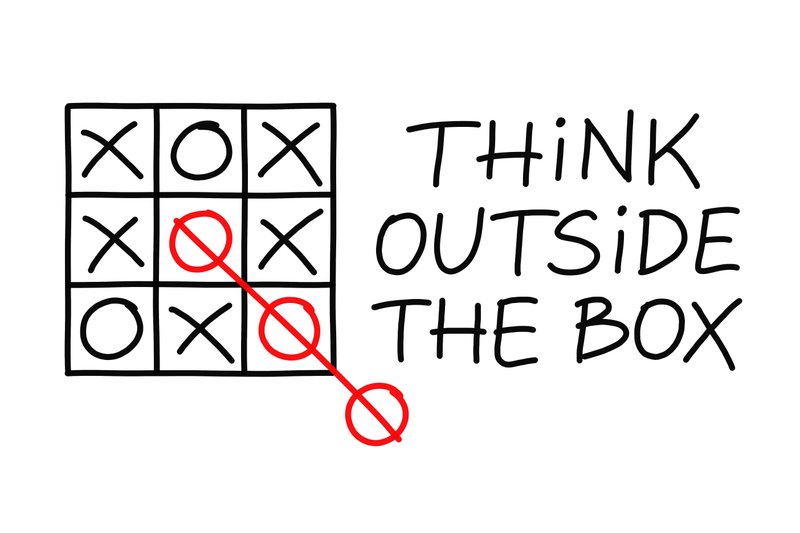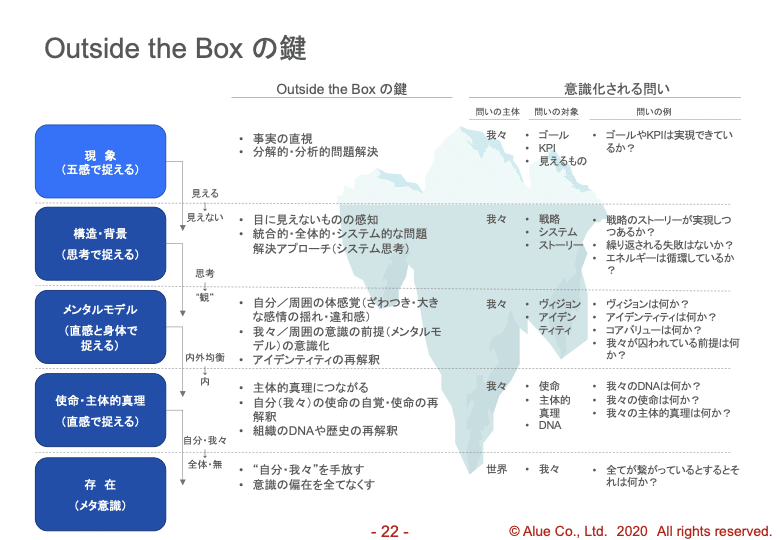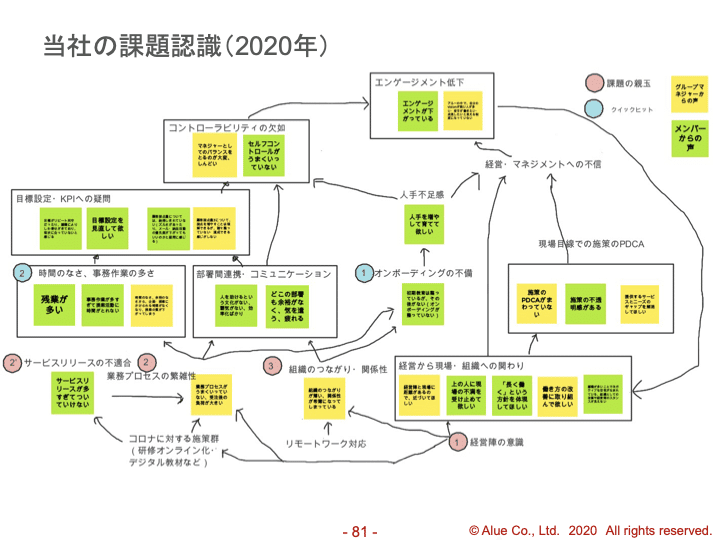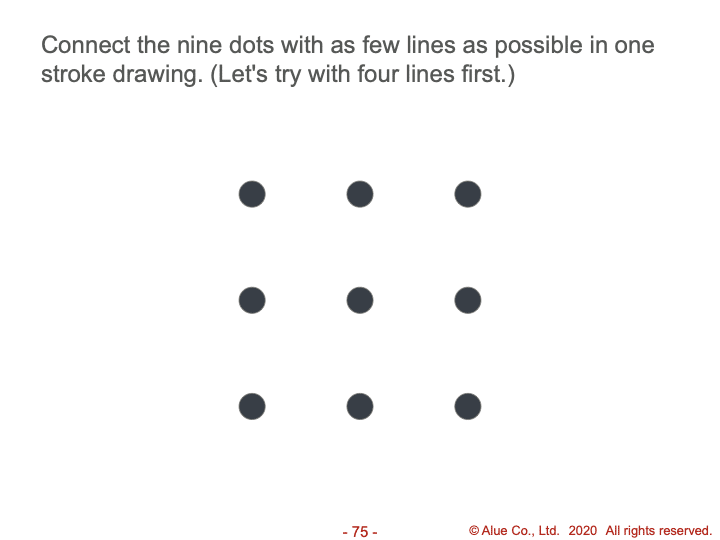
見えている課題は「氷山の一角」にすぎない
前回の記事では、ビジネス・組織運営において難しい課題であればあるほど、人や組織の価値観レベルの変更(=適応課題への対応)が求められるということ、そして、価値観変容の第一歩は、自分に「見えていないもの」があることに自覚的になることから始まるということをお話ししました。
今回の記事では、どのようなモノの見方をすれば、見えるものだけに囚われることなく事象を捉えることができるのかについてお話ししたいと思います。
Outside the box
突然ですが、みなさんにクイズです。

9つの点がありますね。これらの全ての点を一筆書きの要領で繋いでいくときに、なるべく少ない本数の線(画数)で繋いでみていください。
まずは、4本の線分をつなぎ合わせて、一筆書きの要領で、全ての点を繋げますか?
難しいと感じた場合は、5本からやってみましょう。周囲を囲むように繋いでいくと、5本の線分で一筆書きできますね。
5本ができたら、4本に再チャレンジしてみてください。
できた方は3本にチャレンジしましょう。3本もできたら、1本でやってみてください。
いかがでしょうか?答えはここでは示しませんが、答えを見出すポイントの一つは、9つの点で作られる正方形の「枠の外にでること」ですね。

自分たちが普通に考えるときに持ってしまう枠組みを外れること(Outside the box)が鍵となります。これは、前回の記事でお伝えした「見えていないことを自覚する」ということにもつながります。
人はモノを見るときに、何らかの前提や枠組みを用います。例えば、リンゴが目の前にあるときに、「あ、リンゴがある」と理解しますね。これは、その目の前のものを「リンゴ」という言葉で表現されるイメージ・枠組みによって捉えています。
ですから、モノを見るときに、何らかの前提や枠組みを用いること自体は自然なのですが、この前提や枠組みによって「見えにくくなるもの」もあるということに自覚的になる必要があります。
そして、今モノを見ている枠組みを自覚しながら、その枠組みの外側にどのようなことがありえるかを認識しようとすることを、Outside the boxと呼んでいます。

Outside the boxの鍵
では、どのようにすれば、Outside the boxを実践することができるのでしょうか?
最初にお伝えしなければいけないのは、Outside the boxを完全に保証する方法はありません。Outside the boxを実践できる何らかの考え方や枠組みがあったとしても、今度はその考え方や枠組みに囚われることになるという宿命をもつからです。
本質的には、「自分たちは、今どんな枠(前提、常識、前例)に囚われているだろうか?」ということを問い、「その枠の外側には、どのようなことがありえるだろうか?」ということを問い続けるしかありません。
一方で、ビジネス上や組織運営上の改善やイノベーションという文脈に限定すれば、Outside the boxを実践するための補助線となるような枠組みを示すことはできます。
ビジネス上や組織運営上の目に見える現象・課題は全体のごく一部であり、その深層にはいくつもの要因が複雑にからまり合っています。見えているものは「氷山の一角」であり、改善や変革の成否は「氷山の下をどこまで深く捉えることができるか?」にかかっています。
これを表したのが次の図です。

目に見える現象を「氷山の一角」として、その下の見えていない部分をいくつかの層にわけて整理しています。
第1層:現象
目に見える現象は、一番上の「氷山の一角」の部分にあたります。定められたゴールやKPIに達していない、何か具体的な問題が表出している、といった現象から改善・イノベーションの必要性が認識されます。
これはあくまで表層で起きている現象にすぎません。ここから現象の要因となっている構造をどこまで深く捉えるかが、改善・イノベーションのカギです。
第2層:構造・背景
2層目では、起きている現象の背景を一段深く理解しています。いまこの瞬間には目に見えていないものも含めて、「なぜこうなっているか?」を構造的に理解していきます。ここで力を発揮するのは、統合的・全体的に思考することです。物事の関係性を捉え、整理していくイメージです。
より具体的には、事象同士の関係性を整理した構造化マップの作成などが役に立ちます。(以前の記事でお見せしたものの再掲となります)

物事をパターン化して捉える思考も役に立ちます。よくある問題のパターンを認識しておくことで、背景構造に気付きやすくなるのです。
例えば、目標が高すぎて達成のための改善行動に結びつかない、現状維持が最優先で新しい取り組みに手が回らない、といったパターンは様々な場面で見られます。
第3層:メンタルモデル
次の層のメンタルモデルとは、まさに前回の記事で述べた、人・組織の思考モデルや価値観のことです。
前回の記事で述べた当社における変革の例では、ベンチャー起業ならではの「スピード重視の文化」が、成長に従って様々な問題を生み出している可能性に思い至ったことに触れました。
「スピード重視の文化」は、当社がこれまでの成功の中で形成してきた、さらに言えば成功の要因になってきた価値観です。このように過去の成功体験に紐づくような価値観を手放すことには抵抗感が伴います。
このように、メンタルモデルの見直しは自己否定の感覚を伴うリスクがあります。(一方で、自己否定する必要は全くありません。)この層まで掘って自分(たち)に向き合うのは、非常にタフな営みです。
よくあるパターンは、「今やっていることはダメなんだ」と否定だけの感覚になってしまうことです。さらにうまくいかないのは、第三者的な立場の人が「今やっていることはダメだ」と単刀直入に否定してしまうことです。

自分で自分のメンタルモデルに気付くのは難しいですが、逆に他者から見ると、特定のメンタルモデルに捉われている様子が明らかにわかることがあります。過去の成功に囚われて、有効な戦略を打ち出せずにいる企業を見たり、プレイヤー時代の成功体験に囚われてマネジャーとしての効果的な立ち居振る舞いができない人を見たりするときに、そのような感じることも多いでしょう。
しかし、第三者からみて明らかだからといって、本人やその組織の価値観の否定から入っても、当事者は到底受け入れられません。それまでの成功を支えてきた価値観であれば、なおさらです。
むしろ、「これまでがダメだったわけではない」「これまでの成功のためには必然のメンタルモデルだった」というように、これまでの経緯を振り返り、そのようなメンタルモデルをもつことの必然性を認めることから始める必要があります。
時間をかけて、これまでの経験をエスノグラフィーしながら、これまでの歩みを受容していくプロセスが必要です。

現状のメンタルモデルが形成された経緯を受容できると、さらに「大いなる目的」のために、そのメンタルモデルを手放すことを選ぶ準備ができます。これまでを否定するわけではなく、むしろ受容した上で、次のステージのためにモノの見方を変えてみよう、というイメージです。
第4層:使命・主体的真理
「大いなる目的」とつながるのが、第4層の使命・主体的真理です。主体的真理については何回か述べていますが、自分にとって生きがいとなる理想、自分固有の生きる目的のことです。企業の場合はミッションやパーパスに近い概念です。
当社の主体的真理は、「人のあらゆる可能性を切り拓く」ことです。この深層にある想いと照らし合わせたときに、「第3層の「スピード重視」というメンタルモデルを変えるべきか? 」という問いに対して、組織として一定レベルで成長した今のフェーズであれば、その答えはyesだと判断しました。前回述べた変革の裏側には、このような思考プロセスがありました。
課題が第3層のメンタルモデルに起因することが認識されたときに、第4層の使命・主体的真理(大いなる目的)につながることによって、はじめてメンタルモデルを変える決断ができます。大きなる一貫性のために、小さな一貫性を手放すことができます。
第5層:存在
最も深層に「存在」というレイヤーがあります。ビジネス上や組織運営上の改善・イノベーションという文脈においては、直接的にこの層に立ち戻ることは少ないかと思います。一言で言えば、第4層の使命・主体的真理というレベルさえも変わっていくような変革やイノベーションにおいて、立ち戻るものは自分(たち)という存在そのものになるということです。
現代のビジネスにおける企業は、使命・主体的真理などの第4層になる目的格をもとに集まっているコミュニティですから、第4層自体が変わっていくことは稀だと思いますし、それは「企業」の栄枯盛衰そのものを示すものかもしれません。この章においては、第4層までをメタ認知する視点、くらいに捉えていただければと思います。
多次元的に捉える
これまでお話ししてきた通り、ビジネス上や組織運営上の課題の捉え方には、さまざまな階層があります。
このような課題に対して効果的に改善・イノベーションを進めていくためのポイントは、課題を多次元的に捉えることができるかどうかにあります。多次元的というのは、この図における複数の階層に示されるようなモノの見方を持つことができるかということです。
どの階層が重要で、どの階層が重要ではないという話ではありません。どの階層で見た課題のどれをとっても、事実の一面を表していることが多いですし、どれも重要です。

前回の記事で、当社が抱えている課題についてお話ししましたが、これを例にとって多次元的に捉えるということを表現すると次のようになります。
①第1層:現象
・業務が増えた上に業務プロセスが複雑になったことで、現場の疲弊感や、新規入社者のオンボーディングの難しさなど、様々な問題が表出してきた
②第2層:構造・背景
・目標設定やKPIの不整合、事務作業の多さ、部署間連携がうまくいっていないこと、施策のPDCAがうまく回っていないことなど、多くの要因が絡まっている(当社の課題意識2021年初の図を参照)
③第3層:メンタルモデル
・第2層の構造・背景を生み出している組織文化として、「スピード優先」という価値観がある
・経営陣の「前工程(営業やマーケティング)重視、後工程(オペレーション)軽視」という捉え方がある
④第4層:使命・主体的真理
・当社の主体的真理は「人のあらゆる可能性を切り拓く」ことである
このように、目に見える現象は、あくまで「氷山の一角」です。そこから、メンタルモデル、ひいては使命・主体的真理まで捉えていくことが、改善・イノベーションを推し進める鍵となります。

今回の記事では、ビジネス上や組織運営上の課題について、見えるものだけに囚われることなく、多次元的に捉えていくためのモノの見方についてお話ししました。
次回から、改善・イノベーションのプロセスについてお話ししたいと思います。
本日の問いとなります。(よろしければ、コメントにご意見ください)
・あなたの経験の中で、Outside the boxと感じた出来事があるとすれば、それはどのような経験でしたか?
・あなたが課題を多次元的に捉えることによって、うまく課題解決につながった経験があるとすれば、それはどのような経験ですか?
The issues we see are just "the tip of the iceberg"
In my previous article, I mentioned that the more difficult the task is in business and organizational management, the more people and organizations are required to change their value levels (i.e., respond to adaptive challenges), and that the first step in changing values is to become aware of what "we don't see."
In this article, I would like to talk about how we can see things in a way that allows us to perceive events without being limited to what we can see.
Outside the box
Here's a quiz for you.

You have nine dots. Try to use as few lines (strokes) as possible when connecting all these dots in one stroke drawing.
First, can you connect the four line segments together, and then connect all the dots in one stroke drawing?
If you find it difficult, try starting with five line segments. If you connect them in a way that surrounds these nine dots, you can write a stroke with five line segments.
When you have completed with five line segments, try again with four.
If you can do it, try with three line segments, and if you can do three, try one line.
What do you think? The answer is not shown here, but one of the points to find the answer is to go outside the frame of the square made by the nine points.
The key is to go outside the box that we usually have when we think. This is also connected to what I mentioned in the previous article, "being aware of what we don't see.
When we look at things, we use some kind of assumption or framework. For example, when we see an apple in front of us, we understand, "Oh, there is an apple." This is because we perceive what is in front of us through the image and framework expressed by the word "apple."
Therefore, it is natural to use some assumptions and frameworks when looking at things, but we need to be aware of the fact that some things become difficult to see because of these assumptions and frameworks.
And while being aware of the framework in which we are currently looking at things, we try to recognize what is possible outside of that framework, which we call "outside the box."
The key to "Outside the box"
So how can we implement "Outside the box?"
First of all, I must tell you that there is no way to completely guarantee Outside the box, because even if we have some kind of mindset or framework that allows us to implement Outside the box, we are still doomed to be trapped in that mindset or framework.
Essentially, we have to ask ourselves, "What kind of framework (assumptions, common sense, precedents) are we currently trapped in?" and continue to ask, "What is possible outside of that framework?
On the other hand, if we limit ourselves to the context of improvement and innovation in business and organizational management, we can present a framework that can serve as an auxiliary line for implementing Outside the box.
Visible phenomena and issues in business and organizational management are only a small part of the whole, and at the deeper level, there is a complex combination of factors. What we can see is just the tip of the iceberg, and the success or failure of improvements and reforms depends on how deep we can go under the iceberg.
This is illustrated in the following figure.

The visible phenomenon is the "Tip of the iceberg," and the unseen parts underneath are organized into several layers.
Layer 1: Phenomena
Visible phenomena are the "tip of the iceberg" at the top. The need for improvement and innovation is recognized from phenomena such as failure to meet established goals or KPIs, or the emergence of specific problems.
This is just a phenomenon occurring at the surface. The key to improvement and innovation is to understand the structure that is the cause of the phenomenon in depth.
Layer 2: Structure and background
In the second layer, we have a deeper understanding of the background of the phenomena that are occurring. It is a structural understanding of "why things are happening," including things that are not visible at the present moment. What is powerful here is the ability to think in an integrated and holistic way. It is an image that captures and organizes the relationships between things.
To be more specific, it is helpful to create a structured map that organizes the relationships between phenomena. (This is a republication of the figure I showed in a previous article.)

Pattern recognition is also helpful. By recognizing patterns of common problems, it is easier to notice the background structure.
For example, there are many situations where the goals are too high and do not lead to improvement actions to achieve them, or where maintaining the status quo is the top priority and new approaches are not taken.
Layer 3: Mental models
The next layer of mental models is precisely the thinking models and values of people and organizations that we discussed in the previous article.
In the previous article, I mentioned that in our company's example of transformation, I came to realize that the "speed-oriented culture" that is unique to venture businesses may have created various problems as we grew.
The " speed-oriented culture" is a value that we have developed over the years, and even more importantly, it has been a factor in our success. Letting go of these values, which are tied to our past successes, is something we are not comfortable with.
Thus, there is a risk that revising your mental model may involve a sense of self-denial. (However, there is no need to deny ourselves at all.) It is a very tough business to dig down to this layer and face ourselves.
A common pattern is to feel only denial, saying that what one is doing is not good enough. What doesn't work even further is when a third-party person directly denies that what one is doing is wrong.
It is difficult for us to notice our own mental models, but conversely, from the perspective of others, we can clearly see how we are caught up in certain mental models. We often feel this way when we see companies that are stuck in their past successes and are unable to come up with effective strategies, or when we see people who are stuck in their successes as players and are unable to behave effectively as managers.
However, if we start by denying the values of a person or their organization because it is obvious from a third party, the people involved will never accept it. This is even more so when it is the values that have supported their success up to now.
Rather, we need to start by looking back at the past and acknowledging the inevitability of having such a mental model, saying, "It's not that the past was bad," or "It was an inevitable mental model for the success of the past."
It takes time and a process of acceptance of the steps we have taken so far, with an ethnography of our experiences.
When we are able to accept how our current mental model was formed, we are ready to choose to let go of it for the sake of a greater purpose. This is not to deny the past, but rather to accept it and try to change the way we look at things for the next stage.
Layer 4: Mission / Subject Truth
Connected to the "greater purpose" is the fourth layer of mission / subjective truth. As I have mentioned several times, the subjective truth is the ideal that makes life worth living for us, our unique purpose in life. In the case of corporations, it is a concept similar to mission or purpose.
The subjective truth of our company is to "open up all possibilities for people. In light of this deep-seated desire, we decided that the answer to the question of whether we should change our mental model of focusing on speed, which is the third layer, was YES in the current phase when we have grown to a certain level as an organization. This was the thinking process behind the change I described last time.
When it is recognized that the issue stems from the third layer of the mental model, a decision to change the mental model can be made only by connecting to the fourth layer of mission and subjective truth (the greater purpose). We can let go of the small consistency for the larger consistency.
Layer 5: Existence
At the deepest level, there is the layer of "being. In the context of improvement and innovation in business and organizational management, I think it is unlikely that we will return to this layer directly. In a nutshell, in the context of change and innovation, where even the fourth layer of mission and proactive truth changes, what we return to is our very existence.
Companies in modern business are communities that have come together based on a fourth layer of purpose, such as mission and subjective truth, and I think it is rare for the fourth layer itself to change. This may indicate the rise and fall of "companies" themselves. In this chapter, I would like you to think of the fifth layer as a perspective that metacognizes up to the fourth layer.
Multi-dimensional View
As we have discussed, there are various layers to the way we view business and organizational management issues.
The key to effective improvement and innovation in dealing with such issues lies in the ability to view the issues from multiple dimensions. By multidimensional, I mean the ability to see things in the multiple layers shown in this figure.
We are not talking about which layers are important and which are not. Any of the issues we see in any of the layers often represent an aspect of the facts, and they are all important.
In my previous article, I talked about the challenges our company faced, and using this as an example, I would like to express the multi-dimensional perspective as follows.
Layer 1: Phenomena
As the number of tasks increased and business processes became more complex, various problems became apparent, such as fatigue in the frontline and difficulty in onboarding new hires.
Layer 2: Structure and background
Many factors are involved, such as inconsistency in goal setting and KPIs, a lot of paperwork, lack of coordination among departments, and insufficient PDCA (Plan-Do-Check-Action) implementation. (See the figure for our issue structure as of 2020).
Layer 3: Mental model
The organizational culture that gives rise to the structure and background of the second layer is the value of "speed first.
The management team's view of the importance of front-end processes (sales and marketing) and neglect of back-end processes (operations.)
Layer 4: Mission / Subjective Truth
Our subjective truth is to "open up all possibilities for people."
As we can see, the visible phenomena are just the "tip of the iceberg." The key to driving improvement and innovation is to understand the mental model, the mission, and the subjective truth.
In this article, I talked about how to see things in a multidimensional way so that we are not limited to what we can see in terms of business and organizational management issues.
In the next article, I would like to talk about the process of improvement and innovation.
Here are the quests of the day. (If you'd like, please share your thoughts in the comments.)
・If there was an event in your experience that you felt was outside the box, what was it?
・What experiences, if any, have you had where you were able to successfully solve a problem by taking a multidimensional view of the problem?
Bunshiro Ochiai
この記事が気に入ったらサポートをしてみませんか?
